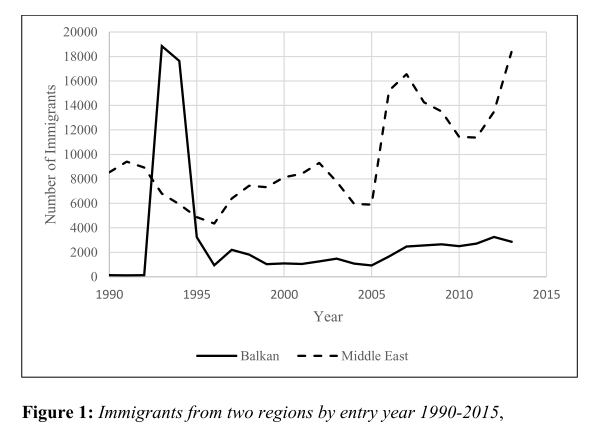Lite ny och gammal forskning om hur det går för utlandsfödda i etniska enklaver
Forskningen om hur det går för utlandsfödda som växer upp i etniska enklaver är spännande. Den ger inte någon entydig bild, men vissa mönster återkommer. I vissa avseenden går det sämre, men i andra avseenden går det bättre.
Här är några intressanta resultat från en studie av Emma Neuman:
The results show that second-generation immigrants raised in immigrant-dense neighbourhoods have a lower probability to continue to higher education, whereas, their earnings, unemployment and social assistance tendencies are unaffected. [...] Moreover, the social assistance and unemployment of non-Nordic second-generation immigrants appears to be negatively correlated with the neighbourhood share of co-ethnics and positively correlated with the neighbourhood proportion of other ethnic groups. Overall, we find that the results are very similar in the short- and long-run.
Nyligen kom också ett nytt wp av Özge Öner och Johan Klaesson med liknande resultat:
Using exogenously defined grid cells to delineate neighbourhoods we find robust empirical evidence that the employment rate of the respective immigrant group in the vicinity (as a measure of enclave quality) facilitates labour market integration of new immigrants.
The influence of the overall employment rate and the share of co-nationals in the neighbourhood tend to be positive, but less robust
Resultaten kommer från två specifika invandrargrupper:
We restrict our analysis to immigrants from the Balkans, arriving in Sweden in 1993 and 1994, and immigrants from the Middle East, arriving in 2005 and 2006

Resultaten ser ut så här: Sannolikheten att få det första jobbet är högre där fler i denna grupp är sysselsatta. Vissa tecken syns också på går bättre där det finns fler från samma invandrargrupp. Sysselsättningen i genomsnitt tycks inte spela någon roll.

Tidigare forskning (inte på svenska data) har haft svårt att hitta några negativa hälsoeffekter av etniska enklaver, och kanske t o m påvisat vissa positiva:
After controlling for confounding, enclave residence was associated with positive perception of general health with borderline significance (prevalence ratio = 1.06, 95% CI = 0.98, 1.15), but not with current smoking, hypertension, and diabetes. Ethnic enclave residence in urban areas may not produce a substantial impact on chronic health outcomes for Asian Americans beyond individual-level factors. [notera att detta dock är en ren observationsstudie]
Slutligen finns studien av Per-Anders Edin, Peter Fredriksson och Olof Åslund i QJE (på svenska data)
When sorting is taken into account, living in enclaves improves labor market outcomes for less skilled immigrants: the earnings gain associated with a standard deviation increase in ethnic concentration is 13 percent. Furthermore, the quality of the enclave seems to matter. Members of high-income ethnic groups gain more from living in an enclave than members of low-income ethnic groups.
comments powered by Disqus